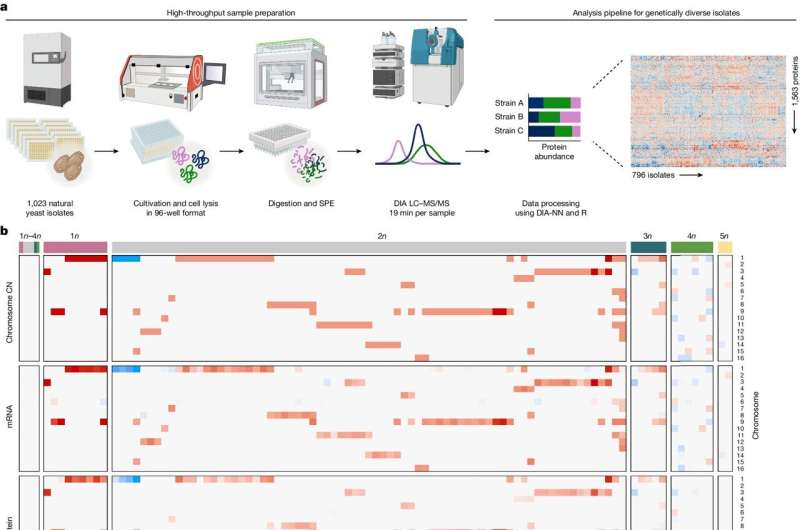This article has been reviewed according to Science X's editorial process and policies. Editors have highlighted the following attributes while ensuring the content's credibility:
fact-checked
peer-reviewed publication
trusted source
proofread
How yeasts manage to compensate for the genetic imbalance of extra chromosomes

Having extra chromosomes is typically an issue for an organism and can disrupt development or cause disease. But some cells benefit instead. For example, cancer cells or pathogenic yeasts can use extra chromosomes to escape treatment and become drug-resistant.
A team of researchers from Charité—Universitätsmedizin Berlin has now deciphered how yeasts manage to compensate for the genetic imbalance. Their findings, published in the journal Nature could yield new approaches to dealing with treatment-resistant tumors or fungal infections.
The typical healthy human cell has exactly two copies of 23 chromosomes, where all of the person's genetic information is stored. If an error occurs during cell division, resulting in three or more copies of a chromosome, that is too much of a good thing. The genes present on the duplicate chromosome are "read" more frequently overall, so their products—proteins—build up to abnormal levels.
This can disrupt an organism's development, as in the case of trisomies like Down syndrome, or make an organism nonviable in the first place. This makes aneuploidy, the medical term for an abnormal number of chromosomes, a frequent cause of miscarriage.
Surprisingly, however, there are also cells and organisms that have learned to cope with the excess of genes and even benefit from it. Some cancer cells, for example, can harness additional chromosomes to better defend against tumor medications and continue to grow despite treatment.
Aneuploidy is also very common in yeasts, a type of single-celled fungus: An estimated one-fifth of all natural strains of the bakery or wine yeast Saccharomyces cerevisiae have an abnormal set of chromosomes.
All proteins exchanged faster
Researchers have been studying how these cells manage to deal with the extra chromosomes for years. A research group headed by Prof. Markus Ralser, Director of the Institute of Biochemistry at Charité, has now traced a previously unknown compensation mechanism based on one species of yeast.
"We were able to show that naturally occurring aneuploid yeast cells buffer the harmful protein burden by exchanging all proteins faster," Ralser explains.
For their study, the researchers compared "genetically healthy" yeast strains against strains in which aneuploidy was induced in a lab and others that had been isolated from a wide variety of environmental niches around the world and had abnormal numbers of chromosomes by nature. Unlike the lab-grown strains, the natural ones had longer to become accustomed to the excess of chromosomes.
For each of the approximately 800 strains studied, the researchers determined the activity of the genes and the quantity of all proteins. To do this, they utilized mass spectrometry, a method that can be used to measure hundreds of proteins from a single sample.
Analysis of these vast quantities of data showed that most of the strains that had been aneuploid for a long time had compensated for the proteins encoded by the extra chromosome, meaning that these proteins were present at levels more similar to healthy yeasts.
Then the team studied how the yeasts achieved this. "Our data show that a system called the proteasome system is ramped up, meaning that the cellular recycling machinery is more active," explains Dr. Julia Münzner, the study's first author, who works at the Institute of Biochemistry at Charité.
"So, cells with extra chromosomes run at full blast, producing a lot, but they are also faster at breaking those products back down."
That reduces the volume of extra proteins, although the turnover of other proteins is also faster. The researchers suspect that the cells have another way to stabilize the non-excess proteins so they are not overly decimated.
An approach to tackle drug resistance?
The researchers hope the new findings can be used as an approach to fighting treatment-resistant tumors and fungal infections. Like cancer cells, pathogenic yeasts like Candida albicans can also become resistant to drugs if they have additional chromosomes. Fungal infections that are no longer treatable can be fatal.
"For example, it would be conceivable to use medications to slow the breakdown of proteins in the cells so they would go back to having to deal with an elevated protein burden," Ralser says.
"That could be a way to prevent treatment resistance." For this approach to work, cancer cells and pathogenic yeasts would have to apply a principle similar to that found in Saccharomyces cerevisiae to tolerate aneuploidy. Finding that out is the research group's next objective.
More information: Julia Muenzner et al, Natural proteome diversity links aneuploidy tolerance to protein turnover, Nature (2024). DOI: 10.1038/s41586-024-07442-9
Journal information: Nature
Provided by Charité - Universitätsmedizin Berlin




















